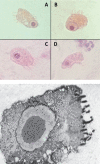Ciliated nasal epithelial cells damage and human rhinovirus infection: cytological findings
- PMID: 32191672
- PMCID: PMC7569584
- DOI: 10.23750/abm.v91i1.8924
Ciliated nasal epithelial cells damage and human rhinovirus infection: cytological findings
Abstract
Human rhinovirus infection has been identified as the commonest cause of common cold. We were therefore interested in cytological assessment of nasal cells from patients with human rhinovirus infection. Cytological examination was undertaken of nasal smears from a group of 7 patients, 4 females and 3 males; aged between 27 and 14 years-old (average = 17.5), who had longstanding perennial rhinitis (in all cases 7 years or more). They presented at our research unit showing clinical symptoms of a common cold, including sore throat, nasal congestion, sneezing, and watery rhinorrhea. Serology and DNA real-time PCR demonstrated human rhinoviruses type A (5 cases) and C (two cases) as the cause of the infection. Nasopharyngeal swabs were taken, fixed with 96% ethanol and stained using the Papanicolaou method and Giemsa stain. Under light microscopy the Pap smears showed the presence of numerous detached ciliated nasal epithelial cells, with approximately one third of the cells showed destruction and irregular attachment of cilia, microvacuolated cytoplasm, and large red round intranuclear bodies, similar to inclusions, surrounded by clear halos, where the nuclear borders were visible. Ultrastructural examination of the cells indicated disappearance of cilia, or shortened, fragmented and disordered cilia. Large intranuclear bodies appeared as a compact mass similar, similar to the condensed chromatin, and separated from the nuclear membrane by a clear space (Figure 1B). No viral particles were observed in the cytoplasm or nucleus. Our results confirm that human rhinovirus can alter the morphology of the ciliated nasal epithelial cells, principally causing alterations to the cilia and provoking nuclear changes.
Conflict of interest statement
Each author declares that he or she has no commercial associations (e.g. consultancies, stock ownership, equity interest, patent/licensing arrangement etc.) that might pose a conflict of interest in connection with the submitted article
Figures
Comment in
-
Nasal cytology identifies healthy and damaged nasal epithelial cells - Reply.Acta Biomed. 2020 Mar 19;91(1):148-149. doi: 10.23750/abm.v91i1.9264. Acta Biomed. 2020. PMID: 32191673 Free PMC article. No abstract available.
Comment on
-
Ciliocytophthoria of nasal epithelial cells after viral infection: a sign of suffering cell.Acta Biomed. 2019 Jan 14;90(2-S):7-9. doi: 10.23750/abm.v90i2-S.8103. Acta Biomed. 2019. PMID: 30715030 Free PMC article.
References
-
- Gelardi M, Iannuzzi L, Seccia V, Quaranta N. Ciliocytophthoria: Cytomorphologic Modifications in Viral Infections of the Nasal Mucosa. J Cytol Histol. 2016:S5:005. Doi: 10.4172/2157-7099.S5-005.
-
- Winther B, Gwaltney JM, Hendley JO. Respiratory virus infection of monolayer cultures of human nasal epithelial cells. Am Rev Respir Dis. 1990;141:839–845. - PubMed
Publication types
MeSH terms
LinkOut - more resources
Full Text Sources
Medical
Research Materials


